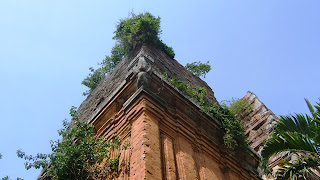This is what I know about the Cham people. Modern Cham, who are a minority ethnic group in Vietnam are descendants of the Champa Kingdom which reigned in central Vietnam from the 7th to the 15th centuries AD. There's a whole lot of stuff about the Champa Kingdom here for those who are interested - but I'll be honest with you - I've only really looked at the pictures on that site. The Champa Kingdom was eventually defeated by the Viet, and one of their legacies has been these beautiful ruins that are dotted about the country.
In Quy Nhon there are two virtually complete towers standing in an area quite close to the center of the city, so while we were there we took some time to go and see them.
Image modified slightly to protect the innocent.
The towers are in such good condition that you can get inside them, so of course we went up. You can see that those steps are very steep - almost as tall as my knee. They're also very shallow - you have to turn your foot on the side to get full purchase, or climb on tippy-toe. I just went very slowly. And apparently the whole world could see up my skirt (that was the last time I wore that dress out of the house!). Mr Martin was very amused.
The towers were built as places of worship, and they're still used as places of worship today. At the top of the stairs in each room was a small room with a simple altar.
Joss sticks were provided in the corner by the door - and a lighter, too.
I felt a little sad that the incense sticks weren't in a nice container - Slide is brand of imitation pringles potato chips. The style of worship here is undoubtedly not like the style of worship at the time these structures were built around 1300 years ago. But it is definitely still a very holy place. Incense sticks were wedged in a few cracks in the wall here and there, as well as on the table.
I was sort of reminded of some of the ancient tombs in Orkney that have Viking graffiti scratched in the walls. These towers have graffiti scratched in the brick walls, too. Who knows how old it is, though. Some of the names look French:
Seeing these photos again reminds me of the builders on my street. Vietnam is a country of brickworks! The Champa were master brickworkers, and they were also master stone carvers.
This is a frieze from around the base of the second tower. There are still a few carvings higher up on the outside of the towers, but most works have long gone. There are lots of examples of the kind of work at the Quy Nhon museum. There are alcoves in the towers, for example where this would fit perfectly.
When you get inside the towers, be sure to look up:
None of the pictures I took could give justice to experience of looking up through those long chambers. It made me think of the stories people tell who have been resurrected from near-death experiences of the 'long tunnel' that leads towards the light.
I also speculated that it might have a telescopic effect on the stars at night. Does anybody know if that speculation makes any sense? I've heard that from the bottom of a well you can see stars during the day.
Those trees would not have been there originally. They're not even really trees - they are self-seeded plants that are growing directly in the mortar at the top of the tower. I think I've mentioned before that the plant life in Vietnam is extremely tenacious.
Dioxin aside, there is nothing standing in the way of new life in beautiful lush Vietnam.
















No comments:
Post a Comment